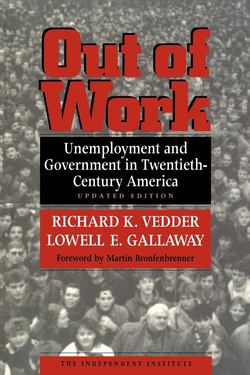Читать книгу Out of Work - Richard K Vedder - Страница 45
На сайте Литреса книга снята с продажи.
THE GENESIS OF THE IMPENDING CRISIS
ОглавлениеWhile there is no dispute that the twenties were a period of great prosperity and little unemployment, it can be argued that the seeds of the economic debacle that followed were being sown during the New Era. There was a tremendous growth in the popularity of an underconsumptionist line of reasoning that rejected the classical doctrine of nonintervention in market processes. In addition, monetary intervention in the form of “fine-tuning” was beginning to be practiced, and this created a tradition of intervention that was to prove devastating a few years later.
The evidence regarding the first point is strong. There was growing respect for what William J. Barber calls the “high-wage policy” from three quarters: businessmen, writers, and government officials.37 High wages meant greater purchasing power and, to some, better worker morale and thus productivity. While Henry Ford popularized the high-wage policy with his five-dollar-a-day wage in the previous decade, others took up the cause. The very highly regarded Boston retailer Edward Filene (patron of the Twentieth Century Fund) wrote in defense of minimum-wage laws and other wage-enhancing measures.38
The view that business downturns and unemployment reflected inadequate purchasing power (what Keynesian economists later called “insufficient aggregate demand”) was popularized by two amateur economists whose books were widely read, William Trufant Foster and Waddill Catchings.39 Some writers, like Stuart Chase and Rexford Tugwell, believed that cyclical fluctuations required governmental planning and intervention.40
The strongest opponent of a noninterventionist, laissez-faire philosophy within government was Secretary of Commerce Hoover. Hoover’s initial appointment to President Harding’s cabinet was strongly opposed by old guard Republicans on the grounds that Hoover was “too liberal, too internationally minded, too popular, and too ambitious.”41 Hoover was sometimes called the Secretary of Commerce and “assistant secretary of everything else.”42
Involved in virtually everything, Hoover believed that the government could enhance efficiency by working with trade associations, by, for example, promoting standardization of measurements and parts among competing firms. A believer in what later was called indicative planning, Hoover took actions to increase economic information (such as initiating the Survey of Current Business) in the hope that it would permit reductions in business cycle activity. He favored strict immigration restrictions and high tariffs as a means of stimulating wages and purchasing power.
Some Austrian economists have suggested that emerging inflationary tendencies in the Twenties contributed to the problems that were to follow.43 To non-Austrian economists, a cursory inspection of the price indices of the period makes one skeptical of this argument, since the consumer price index in 1929 was only 0.4 percent higher than in 1923, while the wholesale price index had declined about 5 percent, and the GNP price deflator also showed a small decline.
At the same time, however, there is some basis for the Austrian position. Typically (for example, after the Civil War), prices fell after wars to levels not too different from those that prevailed before then. Yet, in 1929 consumer prices were higher than at the end of the war, and substantially higher than at the beginning. The money supply (M2) was almost 30 percent higher at the beginning of 1929 than six years earlier, an annual average increase of more than 4.4 percent, and the ratio of reserves to deposits fell significantly while the ratio of deposits to currency rose.44 Between 1923 and 1928, Federal Reserve loan and security assets, reflecting open-market operations and loans to banks, rose a robust 47 percent, signaling an extremely expansionary monetary policy. Nominal interest rates on bonds fell twenty to over one hundred basis points from 1923 to 1928.45
The new central bank undoubtedly contributed to greater monetary expansion than would have existed in its absence, contributing perhaps to the boom in the twenties (by keeping real wages and real interest rates lower than otherwise) and to the subsequent decline, which was aggravated by a retreat from the overexpansionary policy after 1928. According to the Austrian view, a “discoordination” of relative factor prices resulting from the expansionary monetary policy sowed the seeds for the depression that followed. This, of course, assumes that the public’s expectations in this era were slow to react to policy changes (e.g., that money wages were not dramatically impacted by the substantial monetary expansion).
As the Gilded Age wound down, unemployment tended to be low and quickly returned to a normal or natural rate after short-lived increases. By all standards, the years after 1922 were especially successful. Yet, beneath the surface of that prosperity, the basis for future problems was being laid, as a new interventionist philosophy on the part of popularizers of economics, “progressive” businessmen, government officials, and monetary authorities was gradually winning favor, even taking credit for the extraordinary advances that occurred. Increasingly, the view that unemployment fluctuations reflected temporary market disequilibrium was deemphasized and a new, more interventionist approach was gaining respectability. This development would soon contribute in an important fashion to the policy mistakes that would produce the greatest economic downturn ever observed in this country.
